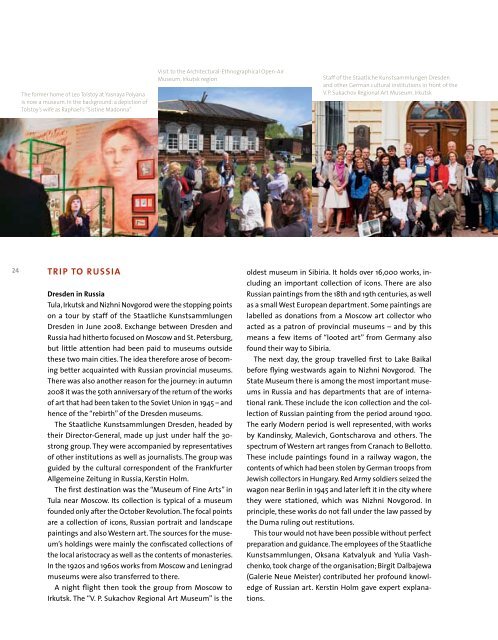2008 - Staatliche Kunstsammlungen Dresden
2008 - Staatliche Kunstsammlungen Dresden
2008 - Staatliche Kunstsammlungen Dresden
Create successful ePaper yourself
Turn your PDF publications into a flip-book with our unique Google optimized e-Paper software.
The former home of Leo Tolstoy at Yasnaya Polyana<br />
is now a museum. In the background: a depiction of<br />
Tolstoy’s wife as Raphael’s “Sistine Madonna”<br />
24 TRiP TO RUssiA<br />
Visit to the Architectural-Ethnographical Open-Air<br />
Museum, Irkutsk region<br />
<strong>Dresden</strong> in Russia<br />
Tula, Irkutsk and Nizhni Novgorod were the stopping points<br />
on a tour by staff of the <strong>Staatliche</strong> <strong>Kunstsammlungen</strong><br />
<strong>Dresden</strong> in June <strong>2008</strong>. Exchange between <strong>Dresden</strong> and<br />
Russia had hitherto focused on Moscow and St. Petersburg,<br />
but little attention had been paid to museums outside<br />
these two main cities. The idea therefore arose of becoming<br />
better acquainted with Russian provincial museums.<br />
There was also another reason for the journey: in autumn<br />
<strong>2008</strong> it was the 50th anniversary of the return of the works<br />
of art that had been taken to the Soviet Union in 1945 – and<br />
hence of the “rebirth” of the <strong>Dresden</strong> museums.<br />
The <strong>Staatliche</strong> <strong>Kunstsammlungen</strong> <strong>Dresden</strong>, headed by<br />
their Director-General, made up just under half the 30strong<br />
group. They were accompanied by representatives<br />
of other institutions as well as journalists. The group was<br />
guided by the cultural correspondent of the Frankfurter<br />
Allgemeine Zeitung in Russia, Kerstin Holm.<br />
The first destination was the “Museum of Fine Arts” in<br />
Tula near Moscow. Its collection is typical of a museum<br />
founded only after the October Revolution. The focal points<br />
are a collection of icons, Russian portrait and landscape<br />
paintings and also Western art. The sources for the museum’s<br />
holdings were mainly the confiscated collections of<br />
the local aristocracy as well as the contents of monasteries.<br />
In the 1920s and 1960s works from Moscow and Leningrad<br />
museums were also transferred to there.<br />
A night flight then took the group from Moscow to<br />
Irkutsk. The “V. P. Sukachov Regional Art Museum” is the<br />
Staff of the <strong>Staatliche</strong> <strong>Kunstsammlungen</strong> <strong>Dresden</strong><br />
and other German cultural institutions in front of the<br />
V. P. Sukachov Regional Art Museum, Irkutsk<br />
oldest museum in Sibiria. It holds over 16,000 works, including<br />
an important collection of icons. There are also<br />
Russian paintings from the 18th and 19th centuries, as well<br />
as a small West European department. Some paintings are<br />
labelled as donations from a Moscow art collector who<br />
acted as a patron of provincial museums – and by this<br />
means a few items of “looted art” from Germany also<br />
found their way to Sibiria.<br />
The next day, the group travelled first to Lake Baikal<br />
before flying westwards again to Nizhni Novgorod. The<br />
State Museum there is among the most important museums<br />
in Russia and has departments that are of international<br />
rank. These include the icon collection and the collection<br />
of Russian painting from the period around 1900.<br />
The early Modern period is well represented, with works<br />
by Kandinsky, Malevich, Gontscharova and others. The<br />
spectrum of Western art ranges from Cranach to Bellotto.<br />
These include paintings found in a railway wagon, the<br />
contents of which had been stolen by German troops from<br />
Jewish collectors in Hungary. Red Army soldiers seized the<br />
wagon near Berlin in 1945 and later left it in the city where<br />
they were stationed, which was Nizhni Novgorod. In<br />
principle, these works do not fall under the law passed by<br />
the Duma ruling out restitutions.<br />
This tour would not have been possible without perfect<br />
preparation and guidance. The employees of the <strong>Staatliche</strong><br />
<strong>Kunstsammlungen</strong>, Oksana Katvalyuk and Yulia Vashchenko,<br />
took charge of the organisation; Birgit Dalbajewa<br />
(Galerie Neue Meister) contributed her profound knowledge<br />
of Russian art. Kerstin Holm gave expert explanations.

















